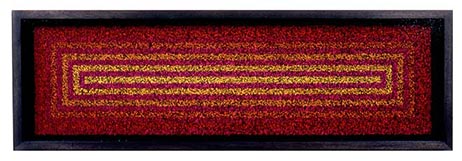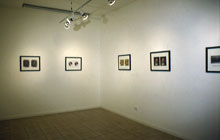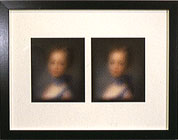Xographs
The term Xograph was conceived by Look magazine and the Eastman Chemical Company to describe the object of their joint efforts to mass produce 3D lenticular screen photographs in the early 1960’s. Like many innovations in 3D imaging, it was hailed as a major leap forward in pictorial representation before failing to develop into anything much more than a novel element in advertising and packaging.
I originally called these optical pieces ‘Xographs’ after the defunct name for the original process with which they share similar optical principals. These include the use of a textured viewing screen that in the case of the lenticular 3D photo, refracts and separates the left and right hand views of the composite realist image placed beneath. The Xographs shown here use a horizontal/vertical glass matrix placed over a line screen which has been generated on a computer and photocopier. Parallax and refraction through the screen produce an ‘active’ moire which accounts for the both kinetic and spatial qualities of the image.
While artists commonly complain that much of their works value is lost
in reproduction, I should point out that in this case it is impossible
to reproduce, in a flat photograph, those qualities of the work that depend
for effect on binocularity. The images shown below are of small pieces
that were exhibited in 1999.
They should give an
idea of the range of composition but (unfortunately) nothing
of the depth or optical kinesis characteristic of the work.






Stereograms
Stereoscopy could be thought of as being simply
an instrument or action that reconciles the difference between any two
images seen simultaneously. Accordingly, the relief into which an image
is cast might indicate a number of things - some of them in spite of
its pictorial currency. The shape of this differential could describe
a duration of time, a chromatic shift, or give an abstract account of
an images volume as easily as it simulates a spatial (and theatrical)
depth.
The job of popular (non-scientific) stereography has always been to embellish a pictorial realism. To this effect it has been a device historically favoured by photographers of exotic travel and of pornography. My interest in stereography is as a means of and as an aid to abstraction. The pieces represented below are quite varied, comprised mostly of elements that are digressions from other lines of research. In some cases an extra dimension has been appended to an image that is already abstract, in others the process of abstraction coincides with the images stereographic ‘materialisation’ by the viewer.






